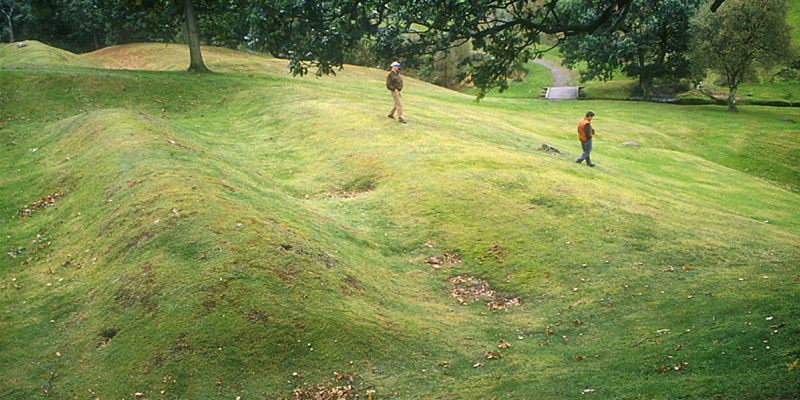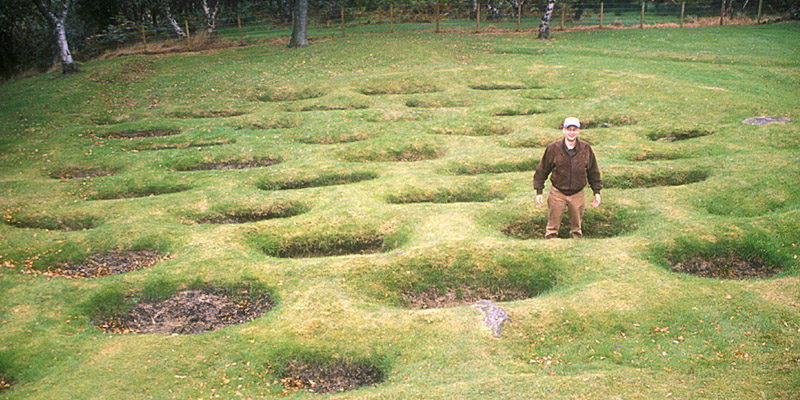


The North Atlantic Arc Home
| September | /Octoberrrrrrrrrrrr |
| S | M | T | W | T | F | S |
| 18 | 19 | 20 | 21 | 22 | 23 | 24 |
| 25 | 26 | 27 | 28 | 29 | 30 | 1 |
| 2 | 3 | 4 | 5 | 6 | 7 | 8 |
| 9 | 10 | 11 | 12 | 13 | 14 | 15 |
| 16 | 17 |
 |
Sunday 9
October 2005Chutes And LaddersI walk into the arrivals lounge at Glasgow Airport to find Ron and Bobby waiting for me. Bobby is holding a small, neatly printed sign that reads MR TATTIE HEID . They landed two hours ahead of me, and have spent much of that time trying to locate Ron s luggage, which has declined to arrive. We have two nights in Edinburgh, and presume that will be plenty of time for the airline to find the errant bag and deliver it. We set out for Falkirk to see the Falkirk Wheel, a modern engineering marvel. It replaces a flight of locks connecting two canals separated by an escarpment, not unlike the Niagara Escarpment, albeit considerably milder. These canals, like any other ones built in Europe or North America in the early nineteenth century, were a vital means of transport before the advent of railroads, but are now used for pleasure boating. The flight of locks took the better part of a day to traverse, and the Wheel takes fifteen minutes to make the same transit. I ve seen the lift locks at Peterborough, Ontario, on the Trent-Severn Canal, and it s an interesting comparison; the two achieve the same goal in different ways. After inspecting this very recent work of man, designed to ease transport over a geographic obstacle, we visit a nearby site known as Rough Castle, which is actually a remnant of the 1,800-year-old Antonine Wall and an attendant Roman fort, which were built to impede, or at least regulate, traffic over the same territory. The wall was built and maintained for only about twenty years in the mid 2nd century, and again very briefly at the start of the 3rd. There is nothing left here but a good length of ditch and bits of earthworks, and the wall was built mainly of turf, anyway; so it is not as dramatic a site as Hadrian s Wall in Northumberland. But I am actually pleasantly surprised by what there is to see, and the impression it gives. We next intend to visit the Abbey and Palace at Dunfermline. We are forced to detour via Stirling and Alloa by roadworks in the vicinity of Kincardine Bridge. We stop for lunch at a small hotel along the A907, at which point we hit the jetlag wall. We decide to skip Dunfermline and get to our hotel in Edinburgh as soon as possible. At least, by coming this way, we get to cross the Forth Road Bridge and view the 19th century engineering marvel of the Forth Rail Bridge. We arrive in due time at our hotel in the Georgian New Town, on the north side of Calton Hill, and promptly crash. We get up in time to have dinner at the Standing Order, a Wetherspoon s pub in a marvelous old bank building on George Street. They pour a decent pint of Deuchars IPA here, and serve passable food fairly quickly. We don t want to waste time; we are headed for the Bow Bar. The Bow sits just to the south of the Royal Mile, just above the Grassmarket. It s a small but handsome room, without the distractions of television, music, or fruit machines, and pretty much embodies everything I think a pub ought to be. Nothing fancy, just the necessities. There are eight real ales on, but I must admit that the only one I care about is Timothy Taylor s Landlord, a Yorkshire bitter that is quite possibly my favorite beer in the whole world. And there are about 125 bottles of malts, not the largest selection in town, perhaps, but enough to keep one busy. Over the next two evenings, I will sample an OB Clynelish, a 14-year-old Glenrothes Provenance from a sherry cask, a Scapa 12, an Ardbeg Very Young, and fabulous Cadenheads bottlings of Clynelish, Ardbeg, and Laphroaig. We have gotten out a bit late, and the Bow closes at 11:00. But the Standing Order is open until 1:00, and we take full advantage! We ll be sorry tomorrow. Next |
 |
The Falkirk Wheel, a late 20th century solution to an early 19th century problem. (2004)
 |
The wheel in action. Round and round we go, you pays your money, you takes your chances. (2004)
 |
The Antonine Wall ran between the firths of Clyde and Forth. Unlike Hadrian's wall,
it was built of earth and timber, so all that's left to see is eroded earthworks and ditches.
 |
Has anyone seen my ball? Defensive pits were dug all along the wall; this is a small field
of some which have been excavated. (How did they know it was a pit if it was full of dirt?)
Next
| September | /Octoberrrrrrrrrrrr |
| S | M | T | W | T | F | S |
| 18 | 19 | 20 | 21 | 22 | 23 | 24 |
| 25 | 26 | 27 | 28 | 29 | 30 | 1 |
| 2 | 3 | 4 | 5 | 6 | 7 | 8 |
| 9 | 10 | 11 | 12 | 13 | 14 | 15 |
| 16 | 17 |
The North Atlantic Arc Home

Mr Tattie Heid's Mileage
Results may vary
MrTattieHeid1954@gmail.com